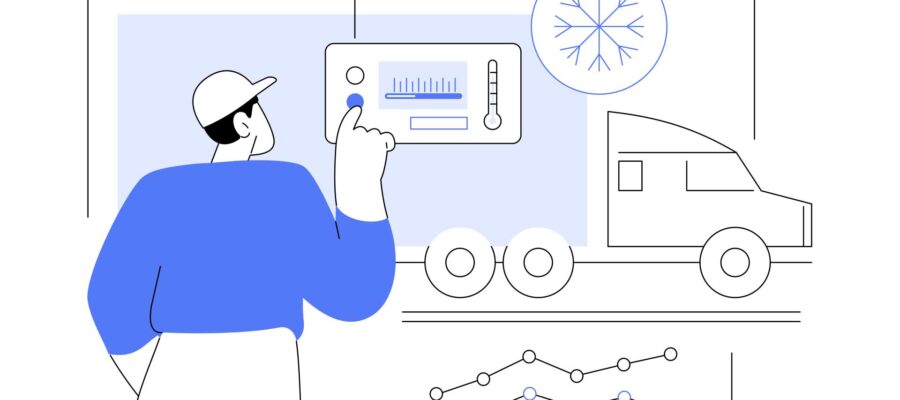This post has already been read 26771 times!
Vaccine transport and storage require well-developed temperature-control processes, or else health and lives can be put at risk.
Without a secure cold chain, the products could spoil, hurting the manufacturers’ bottom line and restricting access to innovations that support public health, reduce fatalities, and control the spread of diseases and illnesses.
Innovative companies are developing new ways to protect the pharmaceutical cold chain.
1. Visible Spoilage Indicators
A lot can happen between when vaccines leave manufacturing facilities and when they reach their destinations. If people doubt that the shipped products have stayed within the required temperature ranges, they may discard them for safety reasons.
3 New Innovations Set to Enhance the Cold Chain, Reduce Health Risks, and Cut Pharmaceutical Supply Chain Costs… Share on XSome manufacturers and tech companies have started integrating freshness verification methods in the packaging of perishable foods. Some of these technologies can determine if refrigerated foods spent too long in warmer environments, or whether products have signs of microbial growth. Such options are better than printed expiration dates. Expiration dates are useful, but they do not account for events (such as safe temperature excursions) that make the product unsafe to consume, even when they’re within the expiration date.
Researchers recently created a proof of concept that could bring visual cues to vaccines and other products associated with specific temperature ranges. Their invention relies on colorful microcrystals that are bright green or red when a product stays sufficiently cool. Then, if the item gets too warm, the particles lose their coloring.
The researchers said this system works on temperatures from minus 94 to 95 degrees Fahrenheit (34.4 to 35 degrees Celsius) and can track temperatures for up to several days. This idea is being further developed to include the microcrystals into vial labels with QR codes.
This work is in its early stages, but researchers anticipate using the technology primarily for improved cold-chain tracking for products in transit.
Monitoring goods stored in warehouses or other static locations is comparatively easy because such facilities usually have sensors to track sudden or gradual temperature changes.
Things become more complicated for goods as they move. Issues such as doors left open, or inconsistent handling practices between multiple courier companies can create serious challenges and vulnerabilities.
Combining a visual spoilage system like this one with real-time Internet of Things (IoT) tracking devices can provide manufacturers and other stakeholders with the assurance that the cold chain is safe and secure.
2. Extending Temperature Ranges with Hydrogel
Most vaccines must stay between 35.6 and 46.4 degrees Fahrenheit (2 and 8 degrees Celsius) during transit. Otherwise, they could lose their potency and may become unsafe for patients.
However, researchers are always exploring possibilities to increase the safe temperature range. This will create more leeway, which is important when bringing vaccinations to areas with limited infrastructure.
How hydrogel and other innovations are enhancing the cold chain in pharmaceutical supply chains… Share on XIn one example, researchers used a biocompatible, synthetic polymer to make a hydrogel that acts as a protective cloak for vaccine proteins and other sensitive components. The team said their innovation extends the viable vaccine temperature range to 77 to 149 degrees F (25 to 65 degrees C). the coating does need to be removed, but it is eliminated with a simple sugar solution. This option protects the drug through much higher temperatures and is quick and easy to administer at the point-of-care.
There is a lot of work still to be done, but hydrogel could make vaccines safer, more economical, and more readily available to those who need them. This innovation has the potential to significantly reduce cold-chain costs by reducing the need for stringent refrigeration across the entire journey of shipments.
3. Using Drones for Transport
Although the examples above are exciting, one of the downsides is they’re still in the early phases of development. Many innovations showing promise in lab environments aren’t always as scalable as people hope. They may also be prohibitively costly at first, limiting overall adoption rates.
That’s why drones are such a promising option for pharmaceutical cold chain scenarios. Using drones takes careful planning because not all areas allow such air traffic. Also, if the flight path between the origin and destination has too many trees or other obstacles, the trip could become impossible to conduct safely. But in the right situations, drone journeys are quick and usually completed within minutes, which means vaccines stay cold without the risk of violating safe-temperature ranges and becoming unusable and potentially dangerous.
Drones are being used around the world, and soon in the US, to ensure safer and cheaper medicines… Share on XIn Malawi in southeast Africa, people relied on a drone to deliver polio vaccines to a hard-to-reach island. Transporting them typically required driving on treacherous roads before sending the vaccines on a half-hour boat trip. The fuel for the journey alone cost the equivalent of about $125. In addition, the journey was slow. A drone can handle the same trip in mere minutes.
In another example, Ohio’s Cleveland Clinic plans to begin using drones to bring prescriptions to patients’ homes in 2025. The company working with the facility to do the job has been sending its drones to transport other cold chain items, such as blood. Having prescription medications sent directly to homes is very convenient, especially for people whose health prevents them from easily leaving their residences to pick up their drugs.
This option will enable deliveries in as few as 10 minutes, and includes real-time tracking of package movements and deliveries. There will be no additional costs to patients. Amazon and Walmart are also testing drone deliveries for limited customer segments. However, Walmart’s service is only for over-the-counter medicines, and these typically do not have such stringent refrigeration requirements. Amazon’s offering includes more than 500 products.
Progress With the Cold Chain
These are some of the most notable innovations that could change how cold chain medications reach clinics, hospitals, and patients. These technologies in the pharmaceutical supply chain promise to make medicines safer and more accessible to more people, at lower costs.

Recommended
- Rethinking Defense Supply Chains with Network-Based Command Centers
- How to Use Predictive Analytics to Streamline Cross-Border Logistics
- AI Plus Humans for Resilient Freight Forwarding in a Complex World
- Modern Defense Supply Chains: The Essential Capabilities for Multi-Domain Operations
- Optimizing Inventory and Logistics for Luxury Retail
- How to Use Predictive Analytics to Streamline Cross-Border Logistics - May 19, 2025
- The Role of Robotics in Advanced Packaging Systems - December 4, 2024
- Ensuring Supply Chain Resilience Through Enhanced Visibility - September 24, 2024
